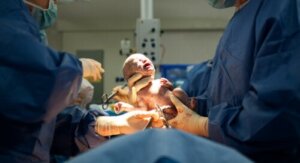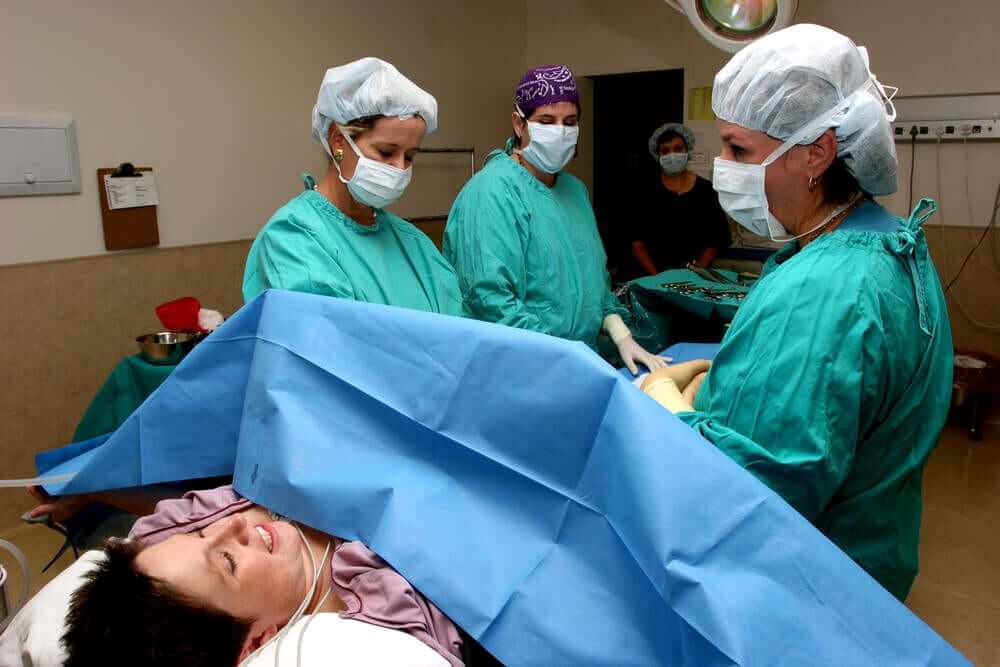Cesarean Sections Continue to Rise, According to the WHO


Written and verified by the nurse Leidy Mora Molina
The World Health Organization (WHO) has shown an increase in the number of Cesarean sections in developed and developing countries. In the ideal scenario, the percentage of this termination route shouldn’t exceed 15% of births, a number that reflects the number of high-risk obstetric pregnancies.
As this entity analyzes, the trend is for the percentage to increase even more in the next 10 years. So, according to estimates, by 2030, one-third of the world’s population will be delivered by cesarean section.
What’s the reason for this increase? Below, we’ll tell you everything about this practice. Keep reading!
Cesarean sections: Necessary versus unnecessary

A Cesarean section is a surgery to remove the baby from the uterine cavity and involves an incision in the mother’s abdomen.
This obstetric procedure is of vital importance in those situations in which vaginal delivery increases the risk of complications for the mother, the baby, or both. Among them, the following situations stand out:
- A disproportion between the size of the baby and the maternal pelvis
- Prolonged labor
- Fetal suffering
- Transverse or breech fetal presentation
- Other obstetric disorders, such as placenta previa or umbilical cord prolapse
- Maternal diseases
- Multiple pregnancies
- Previous cesarean sections (depending on the case)
As a result of these factors, the WHO indicates that between 10 and 15% of pregnancies justify termination by cesarean section. However, in developed countries like Spain, the current rate of this practice is 21%.
So, many times we wonder if these Cesarean sections are really necessary or not. In other words, if they meet the medical criteria for its performance.
For some mothers, a Cesarean section is a valid option that avoids the pain of labor or allows them to choose the date of birth of the baby.
Now, like any invasive procedure, cesarean sections can also bring complications for the mother. This is how WHO expresses itself in this regard:
“C- sections can lead to significant, sometimes permanent complications and disabilities, or even death. Especially in settings that lack the facilities or capacity to perform them safely, as well as to treat surgical complications.”
Possible complications include infections, bleeding, and placental problems. In addition, this procedure can delay the early bond between mother and baby, maternal recovery, and the start of breastfeeding.
It is not the same everywhere
This year, a study was published that compared data on Cesarean sections performed between 2010 and 2018, in 154 countries around the world.
From their analysis, it was determined that cesarean delivery tends to increase throughout the world. In fact, it comprises more than 20% of all births.
The regions with the highest increase in Cesarean sections were East Asia, Latin America and the Caribbean, West Asia, and North Africa.
Finally, the authors of this study estimate that by 2030, 28.5% of deliveries will be by cesarean section. In other words, around 38 million children in the world will be born this way.
The importance of maternal age in choosing the method of delivery
As we know, the risks in pregnancy increase as maternal age increases.
Today, more and more women are postponing pregnancy until after their 35th birthday. And among them, a large percentage opt for assisted reproductive techniques, which significantly increases the rate of multiple pregnancies.
Likewise, some medicalized ways of terminating labor (such as induced labor) are on the rise. In Spain alone, they represent 34.2% of births, according to data from the National Health System.

Final thoughts on the rise in Cesarean sections
With all that’s been analyzed, it’s to be expected that in the next decade, more and more women will require or wish to end their pregnancies with this surgical procedure. However, it’s important to highlight the multiple advantages that vaginal delivery has over Cesarean section when health conditions allow it.
The need for a Cesarean section should be discussed between the professional and the future parents. The obstetrician must advise the family about the woman’s health conditions and also about the advantages and risks of one type of birth or the other.
The choice of a Cesarean section shouldn’t be taken lightly, as it’s a surgical procedure that also involves risks.
The World Health Organization (WHO) has shown an increase in the number of Cesarean sections in developed and developing countries. In the ideal scenario, the percentage of this termination route shouldn’t exceed 15% of births, a number that reflects the number of high-risk obstetric pregnancies.
As this entity analyzes, the trend is for the percentage to increase even more in the next 10 years. So, according to estimates, by 2030, one-third of the world’s population will be delivered by cesarean section.
What’s the reason for this increase? Below, we’ll tell you everything about this practice. Keep reading!
Cesarean sections: Necessary versus unnecessary

A Cesarean section is a surgery to remove the baby from the uterine cavity and involves an incision in the mother’s abdomen.
This obstetric procedure is of vital importance in those situations in which vaginal delivery increases the risk of complications for the mother, the baby, or both. Among them, the following situations stand out:
- A disproportion between the size of the baby and the maternal pelvis
- Prolonged labor
- Fetal suffering
- Transverse or breech fetal presentation
- Other obstetric disorders, such as placenta previa or umbilical cord prolapse
- Maternal diseases
- Multiple pregnancies
- Previous cesarean sections (depending on the case)
As a result of these factors, the WHO indicates that between 10 and 15% of pregnancies justify termination by cesarean section. However, in developed countries like Spain, the current rate of this practice is 21%.
So, many times we wonder if these Cesarean sections are really necessary or not. In other words, if they meet the medical criteria for its performance.
For some mothers, a Cesarean section is a valid option that avoids the pain of labor or allows them to choose the date of birth of the baby.
Now, like any invasive procedure, cesarean sections can also bring complications for the mother. This is how WHO expresses itself in this regard:
“C- sections can lead to significant, sometimes permanent complications and disabilities, or even death. Especially in settings that lack the facilities or capacity to perform them safely, as well as to treat surgical complications.”
Possible complications include infections, bleeding, and placental problems. In addition, this procedure can delay the early bond between mother and baby, maternal recovery, and the start of breastfeeding.
It is not the same everywhere
This year, a study was published that compared data on Cesarean sections performed between 2010 and 2018, in 154 countries around the world.
From their analysis, it was determined that cesarean delivery tends to increase throughout the world. In fact, it comprises more than 20% of all births.
The regions with the highest increase in Cesarean sections were East Asia, Latin America and the Caribbean, West Asia, and North Africa.
Finally, the authors of this study estimate that by 2030, 28.5% of deliveries will be by cesarean section. In other words, around 38 million children in the world will be born this way.
The importance of maternal age in choosing the method of delivery
As we know, the risks in pregnancy increase as maternal age increases.
Today, more and more women are postponing pregnancy until after their 35th birthday. And among them, a large percentage opt for assisted reproductive techniques, which significantly increases the rate of multiple pregnancies.
Likewise, some medicalized ways of terminating labor (such as induced labor) are on the rise. In Spain alone, they represent 34.2% of births, according to data from the National Health System.

Final thoughts on the rise in Cesarean sections
With all that’s been analyzed, it’s to be expected that in the next decade, more and more women will require or wish to end their pregnancies with this surgical procedure. However, it’s important to highlight the multiple advantages that vaginal delivery has over Cesarean section when health conditions allow it.
The need for a Cesarean section should be discussed between the professional and the future parents. The obstetrician must advise the family about the woman’s health conditions and also about the advantages and risks of one type of birth or the other.
The choice of a Cesarean section shouldn’t be taken lightly, as it’s a surgical procedure that also involves risks.
All cited sources were thoroughly reviewed by our team to ensure their quality, reliability, currency, and validity. The bibliography of this article was considered reliable and of academic or scientific accuracy.
- Betran, A (2021). Trends and projections of caesarean section rates: global and regional estimates. BMJ Global Health 2021;6:e005671. doi:10.1136/bmjgh-2021-005671
- Mayo Clinic (2021) Cesárea. Recuperado de: https://www.mayoclinic.org/es-es/tests-procedures/c-section/about/pac-20393655.
- Organización mundial de la salud (2015). Declaración de la OMS sobre tasas de cesárea. Recuperado de: https://apps.who.int/iris/bitstream/handle/10665/161444/WHO_RHR_15.02_spa.pdf;jsessionid=887EDC6FC63B144A37F21ECCFBC8CC97?sequence=1
- Organización panamericana de la salud. (2015). La cesárea solo debería realizarse cuando es medicamente necesaria. Recuperado de: https://www3.paho.org/hq/index.php?option=com_content&view=article&id=10646:2015-la-cesarea-solo-deberia-realizarse-cuando-es-medicamente-necesaria&Itemid=1926&lang=es
This text is provided for informational purposes only and does not replace consultation with a professional. If in doubt, consult your specialist.








